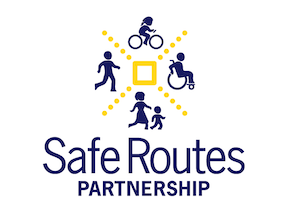Juneteenth was originally celebrated in Galveston Texas, on June 19, 1866. It marked the first anniversary of the day that African Americans there first learned of the Emancipation Proclamation, more than two years after it was initially issued.
Resource Library
We've developed state report cards which provide a snapshot of how supportive each state is of walking, bicycling, rolling, and active kids and communities.
We’ve developed state report cards which provide a snapshot of how supportive each state is of walking, bicycling, and physical activity for children and adults as of 2022.
This promotional toolkit can be used to disseminate the report, “Making Strides: 2022 State Report Cards on Support for Walking, Bicycling, and Active Kids and Communities.”
Safe Routes Partnership is hosting a free webinar on Thursday, July 14 at 1 pm ET.
The Federal Highway Administration released guidance on the Highway Safety Improvement Program (HSIP) (2/2/22) and the Transportation Alternatives Program (TAP) (3/30/22) and held a webinar on the Transportation Alternatives Program guidance (6/2/22).
Key takeaways:
- Active travel to school (ATS) increases children’s levels of physical activity. The result is improved overall health in the bones, weight management, cardiovascular fitness, cognition, and mental well-being.
- There is a lack of accessible surveillance data that focuses on ATS or the physical activity of children. The data that is available is maintained at the local level. There is no comprehensive ATS data that would enable use in policy change or programming requirements at the national level.
- The latest data from the National Household Travel Survey (NHTS) dates back to 2017. While it contains useful information, such as only ten percent of students were walking or biking to school, and beyond a one-mile distance, only seven percent walk or bike to school, the survey is not conducted at consistent intervals. The last time the survey collected information related to ATS programming was in 2009.
- The authors propose that the NHTS should be built using tools such as global positioning systems (GPS), maps, geographic information systems (GIS), and direct observation. These tools can provide a great deal of information about sidewalk conditions, the presence of bike racks, and other characteristics of walkable, bikeable, and rollable routes.
- Using objectively measured data and on-the-ground perceptions together can guide neighborhood-level action.
- ATS surveillance can contribute to policies and programs that support walkability, bikeability, and rollability in the built environment (e.g. sidewalk maintenance policies, Safe Routes to School programs, etc.).
- Equity can be integrated into local surveillance methods, metrics, and analysis more adeptly due to their smaller, more community-based nature. Rather than approaching barriers to ATS from a state level, neighborhood-level surveillance enables the integration of community perspectives.
Our hearts break for the Robb Elementary School community in Uvalde, Texas where 19 children and two teachers were murdered by a person with a gun. They break for the community of Buffalo, New York where parents, grandparents, children, friends, and neighbors were gunned down in the grocery store by a white supremacist. And they break for parents, caregivers, and communities all across the country where guns claim the lives of children and young people whose deaths do not even make headlines.
Two infographics break down the history and current structure of federal funding for Safe Routes to School.
On Wednesday, May 18th from 3pm-4pm CT the Houston Health Department is hosting a free webinar presented by the Safe Routes Partnership:
In partnership with the League of American Bicyclists, Safe Routes Partnership will host a Federal Policy Webinar.
On Tuesday, May 17th from 11 am to noon Mountain, the Colorado Department of Transportation is hosting a free webinar presented by the Safe Routes Partnership:
Check out the new publication Taking on Traffic Laws: A How-To Guide for Decriminalizing Mobility, a collaborative effort between the Safe Routes Partnership and BikeWalkKC!
This guide will help California communities understand the process of applying to the ATP, with our recommendations for how to plan for, draft and submit your application.
On Tuesday, April 19th from 11 am to noon Mountain, the Colorado Department of Transportation is hosting a free webinar presented by the Safe Routes Partnership:
The Safe Routes Partnership is pleased to announce the third and final in the ATP Cycle 6 series of webinars focused on California’s Active Transportation Program: Changes in the ATP Guidelines - Applications and Scoring in Cycle 6.
The passage of the Bipartisan Infrastructure Law paired with the Biden Administration’s release of the National Roadway Safety Strategy makes this a unique moment in to prioritize the safety of people – including young people – in transportation planning and investment. How can you make the most of the focus on a Safe System approach to invest or re-invest in Safe Routes to School?
On Thursday, March 31st from 3pm-4pm CT the Houston Health Department is hosting a free webinar presented by the Safe Routes Partnership: Turning Enthusiasm into Action: How to Get a Safe Routes to School Program Up and Running at Your School.
Check out the new publication Taking on Traffic Laws: A How-To Guide for Decriminalizing Mobility, a collaborative effort between the Safe Routes Partnership and BikeWalkKC!
Join us as we share strategies for designing Safe Routes to School events that serve multiple purposes including encouraging walking and rolling, conducting community research, evaluating your program, and sustaining momentum beyond a single event.

